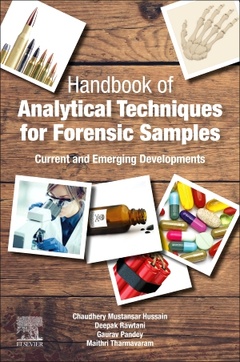Handbook of Analytical Techniques for Forensic Samples Current and Emerging Developments
Auteurs : Rawtani Deepak, Pandey Gaurav, Tharmavaram Maithri, Mustansar Hussain Chaudhery

Handbook of Analytical Techniques for Forensic Samples: Current and Emerging Developments discusses in detail the current trends and latest analytical techniques and methods commonly employed in forensic analysis in order to ensure the proper facilitation of justice. This book is useful for readers who wish to stay updated on the latest trends in the forensic analysis of samples encountered at crime scenes. Technological advancements, such as biosensors, nanotechnology, and taggant technology have upped the level of analysis in forensic science. These emergent technologies, incorporated with existing analytical techniques, are leading to more precise, accurate, and specific examination of forensic samples. Lab-on-a-chip technology has also eased several kinds of on-site analyses done by investigating teams at different types of crime scenes. This book covers the evolution of forensic sample analysis as well as these emerging trends and new technologies.
Part 1: TheorySection I: Sample Analysis in Forensic Science1. Introduction to Chemical Analysis of Forensic Samples2. Forensic Sampling and Sample Preparation Techniques
Section II: Spectroscopic Analytical Techniques in Forensic Science 2. UV-Visible and Fluorescence Spectroscopy for Forensic Samples 3. FTIR and NIR Spectroscopy in Forensic Science 4. Atomic Absorption and Emission Spectrometry in Forensic Analysis 5. NMR Spectroscopy for Forensic Samples
Section III: Electrochemical Analytical Techniques in Forensic Science 6. Voltammetry for Forensic Samples7. Amperometry for Forensic Samples
Section IV: Microscopic Techniques in Forensic Science 8. Optical Microscopy for Forensic Samples 9. Electron Microscopy for Forensic Samples10. Atomic Force Microscopy for Forensic Samples
Section V: Emerging Analytical Techniques for Forensic Samples11. Mass Spectrometry in Forensic Chemistry12. Lab on Chip Devices (Point of care & Point of Need)13. Laser Spectroscopy14. Nanotechnology in Forensic Science
Section VI: Forensic Sample Analysis and Ethics15. Ethics and Legal Issues of Forensic Analysis Techniques
Section VII: Economic and Commercial Aspects of Forensic Analysis16. Economics & Commercialization of Forensic Analysis Techniques
Section VIII: Forensic Analytical Techniques and Future17. Future of Analytical Techniques for Forensic Analysis of Samples
Part 2: Experimental Section1. UV-Visible Spectroscopic Analysis of forensic samples (chemical and biological)2. Fluorescence Spectroscopic Analysis of forensic samples (biological)3. FTIR Analysis of forensic samples (chemical, physical and biological)4. NIR Spectroscopic Analysis of forensic samples (chemical and biological)5. Atomic Absorption Spectrometric Analysis (AAS) of forensic samples (chemical and biological)6. Optical Microscopic Analysis of Physical and Biological Forensic Samples7. SEM Analysis of Physical and Biological Forensic Samples8. TEM Analysis of Physical and Biological Forensic Samples9. AFM Analysis of Physical and Biological Forensic Samples10. Mass Spectrometric Analysis of Forensic Samples (chemical and biological)
Students in analytical or forensic chemistry, researchers and research enterprises in the fields of forensic science and technology, including in engineering, environment, materials science, nanotechnology, energy, and green chemistry
Gaurav Pandey is working as a Research Fellow at the Institute of Research & Development (IRD), Gujarat Forensic Sciences University (GFSU), Gandhinagar, India. His research interests include the use of Nanomaterials for biological applications, especially in the areas of Environmental Science, Drug Delivery and Enzyme Immobilization. He has received his M.S. degree in Forensic Nanotechnology with specialization in Nanobiotechnology from IRD, GFSU. He has also received his B. Tech. degree in Biotechnology from SRM Institute of Science & Technology, Chennai, India.
Maithri Tharmavaram is a Teaching and Research Assistant at the National Forensic Sciences University in Gandhinagar, Gujarat. Her research focuses on creating techniques for surface modification of halloysite nanotubes so they can be used in a variety of biological and environmental applications. She has authored and co-edited a book that was published by Elsevier and has more than 28 articles in peer-reviewed journals to her credit.
Chaudhery Mustansar Hussain is an adjunct professor and director of laboratories in the Department of Chemistry and Environmental Sciences at the New Jersey Institute of Technology (NJIT), Newark, New Jersey, United States. His research is focused on the applications of nanotechnology and advanced materials, environmental management, analytical chemistr
- Includes an entire section of experimental exercises for self-teaching and key concept review
- Covers laboratory protocols used in forensic science laboratories for the analysis of various samples through different analytical techniques
- Condenses the many aspects of forensic analytical chemistry into a single resource with easy-to-understand language for everyone from students to practitioners
Date de parution : 12-2020
Ouvrage de 452 p.
15x22.8 cm
Thème de Handbook of Analytical Techniques for Forensic Samples :
Mots-clés :
sample preparation; UV-Visible; fluorescence spectroscopy; FTIR; NIR spectroscopy; atomic absorption; NMR spectroscopy; Raman spectroscopy; high-performance liquid chromatography; gas chromatography; HP-TLC; mass spectrometry; hyphenated techniques; optical microscopy; electron microscopy; atomic force microscopy; energy dispersive x-ray; d-ray diffraction; lab-on-chip; nanotechnology; quality control; quality assurance



